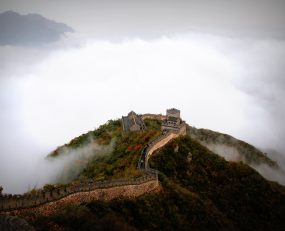
China
China’s historic rise on the global scene comes with geopolitical consequences that will be particularly influential with a retreating US that is seemingly abdicating from its once unrivalled global leadership. China underwent an impressive transformation over the last decades; even compared to its recovery from the Sars epidemic in 2003, when “China was the sixth-largest economy producing 4% of global output with 20m tourists, it is now the second-largest, producing four times that output with 150m tourists”. To cement its legitimacy domestically when the global financial crisis hit in 2008, it invested 12.5% of its GDP in construction, welfare and transport activity to maintain employment levels; while internationally, it embarked on a colossal Belt and Road Initiative, connecting China with Europe and exerting its influence abroad and pulling countries closer into its orbit. Today the Chinese economy is projected to grow “rapidly in proportion to the US economy, from 67% of US GDP at end-2019 to 75% at end-2021”, resulting from a painful contraction in 2020 for the US and relatively stable output projections for China. Additionally, one of the effects of the US-China trade war, intensified by COVID-19 impacts, is that the US has also been outdone by Asian economies, as they, for the first time, have surpassed the US as China’s largest customer, purchasing a total 16% of Chinese merchandise exports versus US’s 14%. Although it certainly continues to depend on a healthy US trading relation, it adds to the picture.
US
While the US’s decline on the global stage is no new occurrence, it certainly gained renewed momentum under the Trump administration. There was little room for ambiguity when it announced its slogan to be “America First” and has made clear its intentions to keep relations transactional and unilateral. Its latest manifestation was an announcement to withdraw from the World Health Organization, in the midst of a pandemic. In fact, far from championing a global response to the health crisis, in most recent news, the US has instead almost cleared the world’s supply of Remdesivir, which is one of just two drugs that have been proven to effectively treat COVID-19 and continues to portray the pandemic struggles as somewhat of an international competition, rather than a common threat. The President has also made no effort concealing his disapproval of multilateral institutions that have supported stability and growth over the last decades and frequently undermined them. According to Noah Smith writing for Bloomberg, US is also on the decline domestically, where every one of the systematic economic advantages once possessed by the US are currently under threat and might even eventually lead to a crash of domestic and foreign investor confidence, erasing US’s general effectiveness as a country.
EU
The EU finds itself in a precarious position; seeing the US slowly withdrawing and leaving them more exposed to Chinese influence and its relationship is nowhere near as clear-cut as the US-China one. The EU has a great interest in not being caught up in the rivalry and be marginalised as the rift unfolds, Joseph Borrell, the High Representative of the EU for Foreign Affairs and Security Policy, described it as, “China is simultaneously a partner with whom the EU has closely aligned objectives; a negotiating partner, with whom the EU needs to find a balance of interests; an economic competitor in pursuit of technological leadership; and a systemic rival promoting alternative models of governance”– for a bloc of 27 member states, quite the feat to find common ground and coherent policies with. China’s BRI efforts have been worrying, if not alarming, EU leaders as well; so far 13 EU member states have signed up to the BRI, but Italy’s decision to officially join was received with much unease as the first G7 country that joined. Matters were not helped when there had been an initial lack of solidarity from the EU towards its more vulnerable member states and Italian resentments were allowed to grow and were initially looked after by generous donations of facemasks, respirators and medical assistance from China. As the Coronavirus is wreaking havoc on economies, they will become more vulnerable to influential investments and the combination of an absent US and strong Chinese economic superpower suggests the possibility of further realignments.
That being said, a Chinese-led world is still a distant possibility, however, favourable circumstances are in place and show little sign of slowing down. The continuation of these trends allow for more of the vacuum being filled with values that will not resemble the world the last generations have been accustomed to and will have a resounding impact to economic relations as well. Despite China’s remarkable economic growth, its rift and tensions with liberal democracies has not abated. Both sides still regularly clash over subjects such as transparency, intellectual property, aggressions in the South China Sea and stricter security laws in Hong Kong by mainland China – all in addition to responsibility for the COVID-19 pandemic crippling economies across the world.
The decline of US leadership, combined with a forcefully rising China and a recovering Europe has far-reaching implications for global trade and its existing structures in terms of supply chains. Imagining a China-less supply chain in the near future is nearly impossible and infeasible when its annual manufacturing output is so large “that even a group of countries would struggle to absorb it”, especially while many companies and economies are currently struggling to survive with only limited cash flows. Nonetheless, some degree of decoupling and diversifying is well underway, along with a potentially slightly unfamiliar global order. The next brief in this series will look in detail at one of those trends gaining lots of traction lately; de-coupling.
Source: Transport Intelligence, July 2, 2020
Author: Dila Cebeci